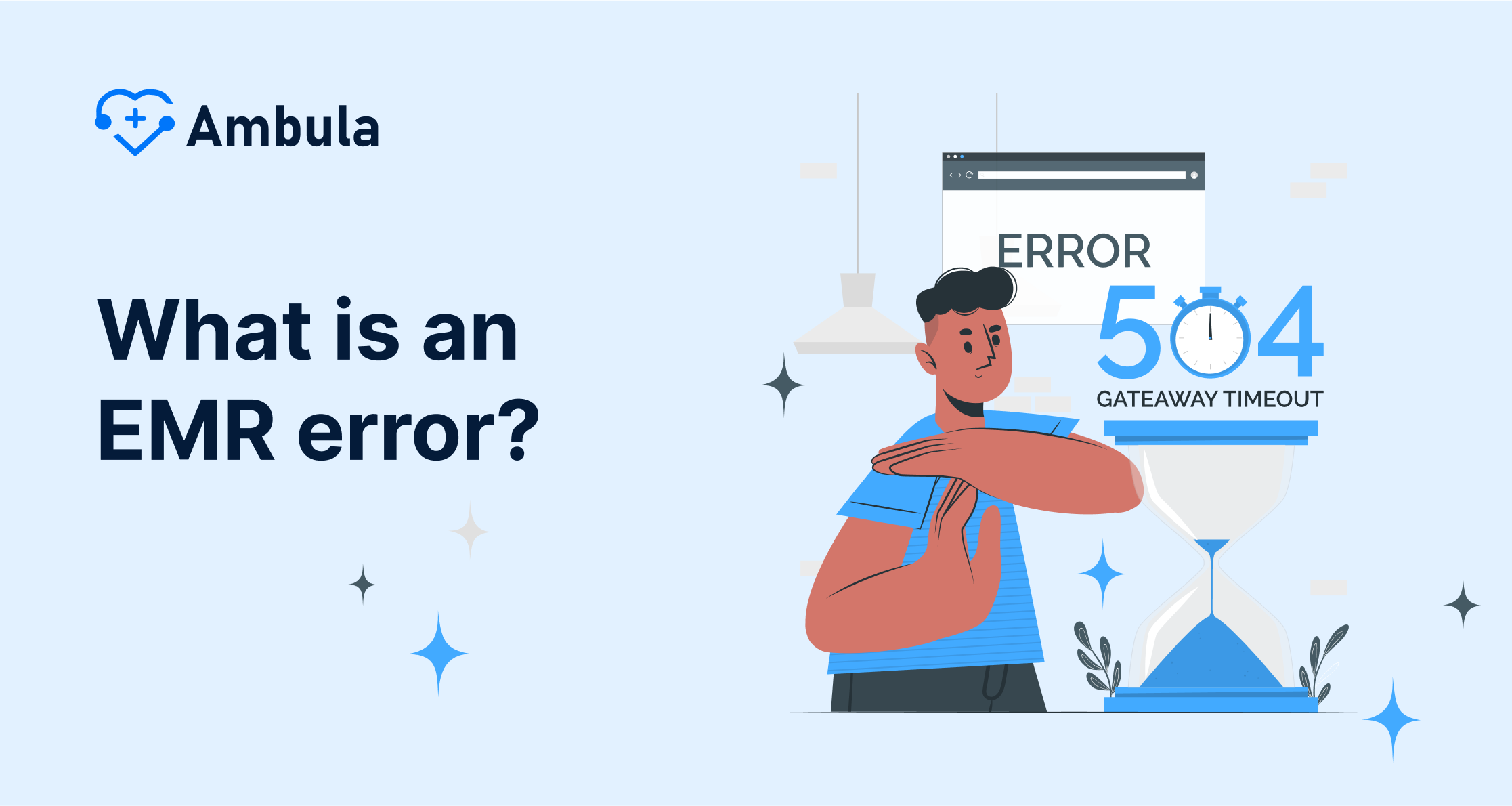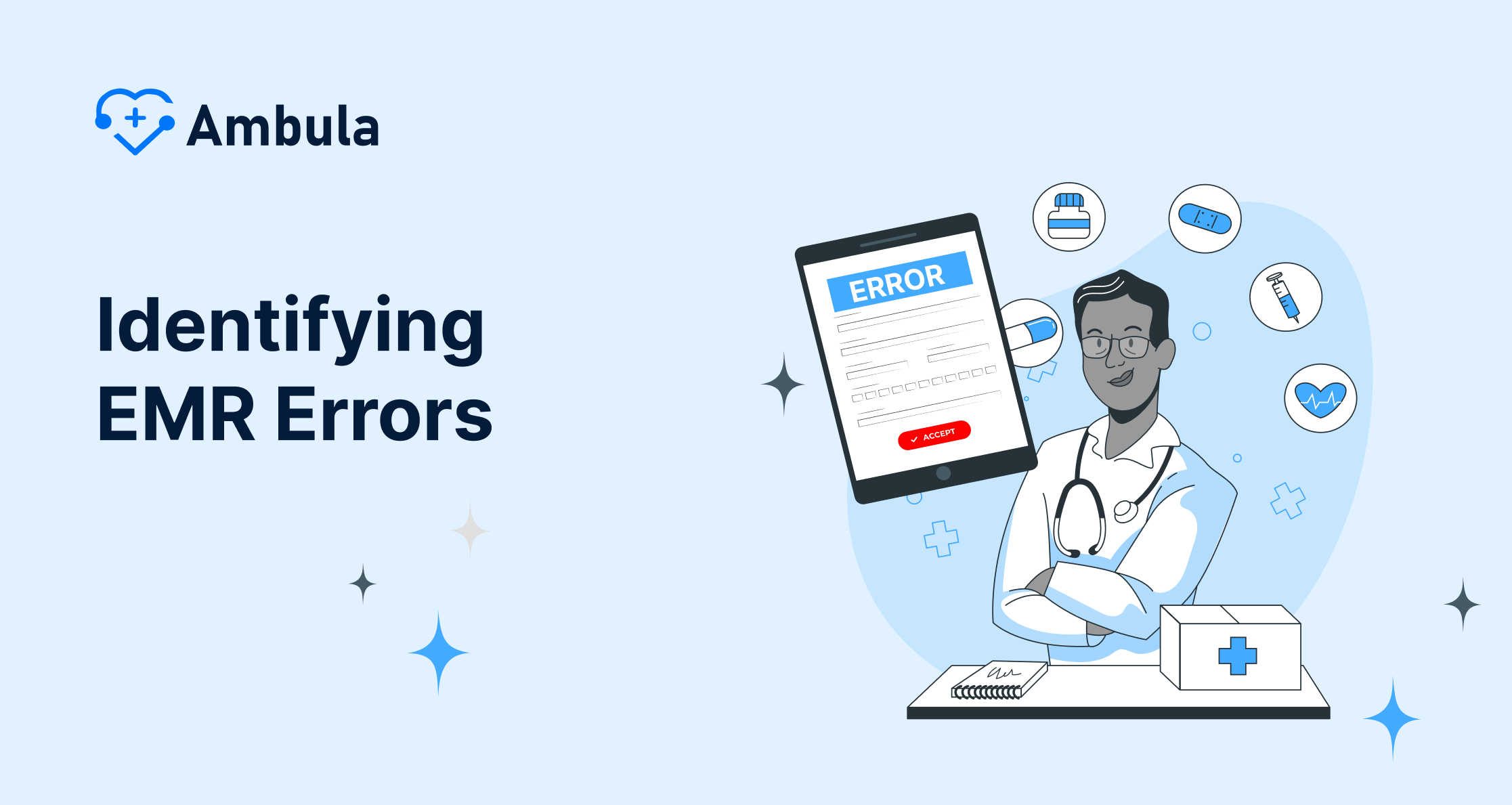How do we correct an EMR error
Topics:
- What is an EMR error?
- Identifying EMR Errors
- What is an EMR experience?
- Correcting EMR Errors
- Managing EMR Error Correction Workflow
- What types of errors occur in EMR?
- The EMR market
- How do you choose the best EMR for your practice?
What is an EMR error?
Mistakes happen, but how do you fix a mistake in an “electronic health record”? When a blunder pops up in your EMR, you gotta first pinpoint which patient’s record got the slip-up. Then you dive in and find where the goof sits in the record.
Electronic medical blunders mean the slip-ups or issues popping up in electronic health records (EHR) or various health IT systems. Stuff like software hiccups mistakes in data entry wonky interfaces, or data that’s gone AWOL can mess up how patients get treated, lead to wrong diagnoses, goof-ups with meds, or other nasty health snafus. Knowing the right moves to fix medical record mistakes is a must to keep data quality on point.
Spotting EMR Goofs
Finding errors is super important for keeping electronic medical records (EMRs) right and trustworthy. EMRs are a big deal for taking care of patients, and when they’ve got mistakes, they can cause big trouble, like wrong diagnoses, treatments that don’t fit, and bad things happening to patients. So, like, health places gotta have strong ways to spot and fix EMR mistakes fast, and that means having things like quality checks and standard procedures in place.
Typical Mistakes in EMRs
You can spot EMR mistakes in a bunch of different ways such as:
- Blunders in Typing Stuff In: People make these screw-ups when they’re inputting data. You might see stuff like patient info that’s borked, meds given at the wrong dose, or sickness names that got typed funny. Even mix-ups with who’s who in patients happen.
- Buggy Computer Programs: Sometimes, computer programs go bonkers and mess up the electronic health files with their bugs or breakdowns. That can mean you get the same thing in there more than once, info might vanish, or the number-crunching goes haywire making us look at the problems with digital health files.
- Stuff That’s Not There: When there’s bits missing in the health records taking care of patients the right way gets tough. This is like not having the old doctor’s visits, test results, or scans handy in the file.
Ways to Spot When Health Records Go Wrong
We got a few methods to spot mistakes in Electronic Medical Records (EMR):
- Checking by hand: Doctors often have to go through EMRs themselves to find any mistakes. It’s a slow process, and they might miss the small stuff.
- Using tech: There’s cool software that hunts for things that don’t add up in EMRs. This tech marks stuff that might be wrong so peeps can take another look—this is one way how EHR reduces medical errors.
- Hearing out Patients: When patients point out what’s off in their own medical records, it’s super helpful. You can hear what they got to say through surveys online patient areas, or just talking straight with the medical team.
Understanding EMR Experiences
What’s the deal with EMR experiences? Before we dive into the process of making amends to a digital medical record, it’s key to untangle the mix-up between Ehr versus Emr—two terms that lots of folks use as if they mean the same, but they don’t. Let’s say we’re looking at EMRs, which are like old-school paper records turned into techy versions. They’re awesome for a few reasons:
- They keep track of your health stats over time.
- They flag up peeps who need to get their routine checks or tests done.
- They’re handy for boosting the care quality you get in a clinic.
- They let doctors see how you’re doing on various health fronts.
EMRs differ from EHRs because they keep data within the practice, limiting the system’s scope of experience.
Check out these articles after you’re done
Fixing EMR Mistakes
Making sure electronic medical records (EMRs) are error-free is super important for keeping patients safe and making sure their medical info is correct. It’s super necessary to have a quick and orderly way to fix these goofs to keep folks from getting hurt. Getting why fixing a doc goof is a big deal and sticking to the top ways to make EMR mistakes right are major.
Main Rules for Fixing EMR Goofs
Okay so there are some big-time rules that you gotta follow when you’re tidying up EMR mess-ups:
- Don’t Chuck Out or Hide the Real Deal: Don’t scrub the first bit of info. Instead, flag up the mistake and slap down what’s right. This way, the full story of the patient’s care stays intact, and peeps can look back on it later. Go for an addendum or late entry when you’re sprucing up medical records the right way.
- Make Sure the Fix Stands Out: When you sort out the entry, make it super obvious and keep it separate from the original. Gotta make sure the docs and nurses catch the switcheroo so they can make heads or tails of the record. Getting the authentication spot on is mega important.
- Give a reason for each fix. A quick explanation for each correction helps grasp why the mistake happened and stops the same error from showing up again. Writing down errors is crucial in learning the right way to fix stuff in digital health files.
Dodging Mistakes in Digital Health Files
It’s super critical to dodge goof-ups in electronic health records, ya know, for keeping folks safe and making sure the healthcare they get is top-notch. Health places gotta be on their toes and take steps to keep these slip-ups in electronic records to a bare minimum and keep patient info on the level. Setting up these digital records right and making sure everyone knows how to use ’em is key to steer clear of mistakes.
Boosting How We Put in Data and Get Good with the Programs
So when health services roll out real good training stuff, they make sure everyone’s way better at typing in patient data and getting the hang of the software, which means there are fewer mess-ups with the records. This kind of learning should cover:
- Training on Precise Data Entry: Doctors and nurses need solid training in entering data right, like using the right format, checks for correctness, and ways to stop mistakes from happening. Doing this makes sure all the stuff they put into Electronic Medical Records is on point, which is super important to keep wrong diagnoses out of EMRs.
- Getting Good with EMR Software: It’s mega important to train healthcare workers on the exact EMR system they’ll be using. They gotta get the hang of all its cool features how to get around it, and spots where they might slip up. When they know their tech well, there’s way less chance they’ll mess up ’cause they didn’t know better.
Training to Recognize and Report Mistakes: It’s important to teach providers how to spot possible slip-ups and let the right people know through the proper reporting channels. By doing this the right way, we can catch and fix mistakes fast stopping them from flying under the radar and messing with patient care.
Handling Mistakes with EMR Systems
It’s super important to handle errors in the electronic medical records (EMR) system well. You gotta make sure you fix mistakes fast, right, and the same way every time. For this, you use what the EMR software gives you make fixing errors a normal part of the whole EMR thing, and use tech to make it all go smoother. Getting EMR management right is a must.
It’s a big deal to mix error fixing right into the EMR routine. You need good rules and steps for spotting telling others, setting right, and double-checking mistakes. Plus, you need to make sure everyone on the healthcare squad knows who does what so nothing gets ignored. Training and teaching the healthcare folks makes sure they know how to fix mistakes in medical records.
What types of errors occur in EMR?
It is important to learn the types of errors to answer how we correct an EMR error. Two types of errors can occur inside EMR experience healthcare scenarios. Human errors and system errors. You can fix some of these as stated above. Human error types can come from a lack of EMR experience required and might include as examples:
- Using the copy and paste function multiplied as per copying operation repetitiveness
- Errors in entering data while typing from a paper record
- Intentional or. Accidental records deletion
- Data breaches and unauthorized log-ins
How do patients protect themselves from human errors
For the patients to protect themselves from human errors, they should:
- Request a copy of your medical records
- Review their prescriptions
- Look at their lab work
- Keep notes
Normally, EMR software is there to reduce errors. However, some types of errors can happen within the system itself. These types of errors need engineers and your initiative to contact your service provider:
- Increased provider time
- Lack of standards
- Computer downtime
- Threats of confidentiality
Impact of Electronic Medical Errors
- Immediate Impact on Patient Health
The most direct and immediate potential consequence of an electronic medical error is its potential to cause harm to the patient’s health. For example, if a healthcare provider enters incorrect information into a patient’s electronic health record, such as misinformation about allergies or pre-existing conditions, it could lead to incorrect diagnoses or inappropriate treatments. Similarly, if the system fails to highlight a serious drug interaction due to an error, it can lead to dangerous, potentially life-threatening side effects. - Extended and Long-term Impact on the Healthcare System
Beyond the direct harm to the patient, electronic medical errors can have broader, long-term implications for the healthcare system. They can cause delays, as healthcare providers must spend additional time remedying these errors, impacting the efficiency of medical services. This can lead to patients mistrusting electronic systems and preferring manual procedures, hindering technological advancement in the healthcare sector. Furthermore, these errors can lead to increased healthcare costs, as incorrect or inappropriate treatment can prolong a patient’s hospital stay or necessitate additional or more expensive procedures.
The EMR market
Here are some facts to know about the EMR market:
- There are hundreds of companies in the EMR market, which makes it highly competitive and efficient at the same time.
- There are concerns about IT staff because not all medical practices have an IT department to maintain, fix, and implement the software.
- The growth of the market has been remarkable, thanks to the incentive
- Security breaches and data storage are top priorities for participants.
How do you choose the best EMR for your practice?
Finally, how do you choose the best EMR for your practice? First, you should know that implementing EMRs takes time and capital. Therefore, you need to choose wisely. Therefore, we present you the steps required:
- Compose a list of your practice’s needs
- Do some budget analysis
- Consider only specialty-specific EMRs
- Take into consideration the systems architecture for your particular practice
- Make sure of the certification of the EMR system
- Take advice from other users
- Decide on the volume of your support
- Get a lawyer to review the agreement of purchase
- Give the right time for installing
Whether the error is human or software-related, the times are advancing towards an error-free environment. Of course, EMR is on the way to accelerating this shift.
For additional information, do not hesitate to contact our Ambula Healthcare team: (818) 308-4108! And now, check out How to operate an EMR system!








